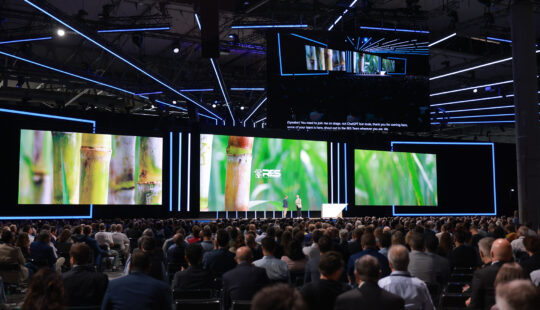SAP’s vision is to enable customers to successfully transform their businesses into intelligent, sustainable enterprises. Collaborating closely with our customers and partners, we help to optimize their material, financial, and energy flows throughout end-to-end business processes in order to address planetary challenges.
With our application portfolio, industry expertise, and extensive business network, we aim to enable emissions reduction and help tackle the ocean plastics crisis. We aspire to infuse sustainability into all relevant core business processes by focusing on regulatory compliance, operational excellence, and responsible innovation and growth — going beyond the traditional scope of value creation.
We believe that the path to a low-carbon future is circular. Only when businesses are moving beyond their siloed approaches, commitments, and climate pledges, fully embracing sustainability, and embedding these ambitions in an integrated way will we be able to drive systemic change. The good news is that a circular economy is not just about fixing environmental wrongs. Evidence shows it can bring big opportunities and drive positive impact across industries, sectors, and lives. Working toward a circular economy can protect human health and biodiversity in many ways, including better use of natural resources, such as protecting water and land, thus mitigating the climate crisis.
The role of a circular economy must expand to successfully reduce emissions across sectors, as it is an essential component to achieving climate neutrality.
Sustainability management by SAP, launched last month at the first SAP Sustainability Summit, showcases our suite of sustainability solutions that can help organizations in their journey to becoming a sustainable enterprise. We aim to enable organizations to assess and reduce their carbon footprint, increase resource productivity through circular processes, and run safer, sustainable business processes. This will also include industry-specific insights that combine operational and financial data across value chains embedded in core business processes.
Our portfolio addresses four dimensions of sustainable transformation.
Climate Action
With SAP Product Footprint Management, planned for availability in the third quarter of 2021, our ambition is to provide customers with product footprint transparency. This will equip them with the insight to reduce carbon emissions across their value chains while enabling them to exchange data with their customers, suppliers, and business partners — driving transparency across a company’s scope 1, 2, and 3 operations.
Carbon is increasingly becoming a global, universal currency that can be tracked, traded, managed, and minimized like any other resource. Learn more about how to do this in the product preview for SAP Product Footprint Management here.
Circular Economy
With SAP Responsible Design and Production, planned for availability in the fourth quarter of 2021, we aim to further our vision for a plastic-free ocean by 2030. By preventing waste and pollution, using products and materials for longer, and applying circular principles, we can regenerate natural systems and make better use of finite resources. Successful execution on circularity will bring the upstream visibility for sustainable inputs together with downstream visibility, thus enabling reverse logistics and product authentication, promoting reuse across the product’s life cycle.
Extended producer responsibility is our first step in building resilience and circularity principles into material flows throughout value networks.Learn more about our vision for extended producer responsibility here.
Holistic Steering and Reporting
The upcoming SAP Sustainability Control Tower solution will meet the hyper transparency needs of our customers on their environmental, social, and governance (ESG) performance through a higher level of granularity than historically available through reporting and disclosure. We want to provide focused analysis on the most important data in real time, protecting against business risks, tying it back to underlying business data.
A successful ESG information architecture must meet the needs of external audiences and internal managers at the same time. Explore how SAP customers can start their journey towards holistic steering and reporting here.
Socially Responsible Value Networks
The journey to support our customers’ ambitions has only just begun, and there is a huge potential to make this vision bigger and stronger through collaboration with our ecosystem. As an example, with SAP Business Network, we support continuous improvement in safe, equitable, and compliant businesses, within the company and across the value network. Other examples include the planned inclusion of the sustainability scores of suppliers during the purchase requisition process, so that procurers are informed on the sustainability profiles of their suppliers.
With sustainability management by SAP, we embed sustainability as a new dimension of success while delivering incremental innovations in our sustainability product portfolio, which is modular, integrated, and embedded along end-to-end business processes in the Intelligent Enterprise, starting with SAP S/4HANA. To execute on this vision, we will collaborate with our ecosystem across industries to innovate on top of SAP Business Technology Platform.
To achieve these ambitious goals, we need to continuously challenge ourselves and work together with customers, partners, non-governmental organizations (NGOs), and regulators for sustainable product life cycles across the value chains.
We are delivering jointly on the United Nations Sustainable Development Goals (UN SDGs) through the SDG Ambition accelerator. Learn more about our innovation journey here.
To keep updated on the latest product innovations, visit the SAP Sustainability Summit website, which will guide you on transformative actions toward a more sustainable future.
Enabling tomorrow starts today.
Gunther Rothermel is senior vice president and head of Sustainability for SAP S/4HANA.
Anita Varshney is global vice president of Strategy for Sustainability for SAP S/4HANA.



